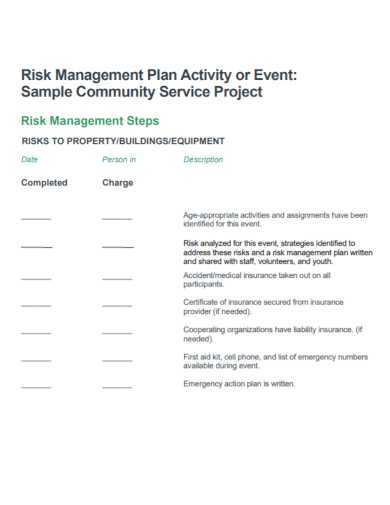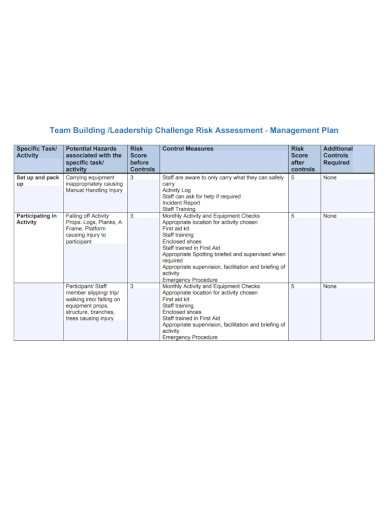A number of accidents that occurs in business establishments are caused by failure to undertake a proper risk management plan. Buildings are no exceptions to these and the process involves planning, monitoring, and controlling instances of risk and the hazards it presents. A proper property risk management can help control unwanted consequences and create action plans to administrate and implement polices and changes in your property. Know more about in this article and don’t forget to check out our free risk management plan for buildings samples below:
3+ Risk Management Plan for Buildings Samples
1. Risk Management Plan for Buildings
2. Risk Management Plan Project for Buildings
3. Building Risk Assessment Management Plan
4. Organisation Buildings Risk Management Plan
What Is a Risk Management Plan for Buildings?
Whether this in a construction industry or commercial or rental properties, a risk management plan is a must have in both operations. We define a risk management plan as a comprehensive document that address risks, their potential impact on a program and consists of ways to reduce these risks. This is a continuous process that should begin at the earliest stages of program planning. An effective risk management depends on risk management planning; early identification and analyses of risks; early implementation of corrective actions; continuous monitoring and reassessment; and communication, documentation, and coordination.
How to Compose a Risk Management Plan for Buildings?
An important part in building or property management is risk assessment and aligning this with a risk management plan. We can’t predict exactly what will happen, or when a risk will present itself, but we can use experience, wisdom, research, and foresight to remain as prepared as possible and keep ourselves all set when risks materialize. To get started these are the following propositions you can look at for your risk management plan:
I. Risk Identification
Regularly inspect the property as part of a thorough building maintenance program. With this procedure, management can sort out and identify by taking note of deficiencies, such as health or safety problems. Create and retain copies of your inspections and document the items that were promptly and professionally addressed.
II. Risk Assessments
Risk Assessments is a recognized and formal process for assessing and controlling risk. These are identified by examining each scenario and process element in terms of the sources or areas of risk. This could be done by collecting feedback and or complaints which can be accumulated and serve as references for a risk management plan.
III. Assign Ownership for Each Potential Risk
Assign specific team members to oversee risks, have your list prioritized and know how many resources you’ll need on each risk. Transferring risk ownership will help keep an eye for each problem, and helps in resolving issues quickly and efficiently. This could also be done using vendors, suppliers or qualified contractors that are more adept in regards with this situation.
IV. Preventive Response
Appropriate measures should be established once risks are identified such as removal of certain risks or never allow them in the first place around your establishments or property. Your risk management plan should be visible across all team members so that everyone knows which risks to watch out for, and who to contact should one of them arise.
V. Monitoring Risk
Risk can happen anytime and anywhere, and no matter how an organization is careful, incidents are still likely to happen whether old or new. Risk management main purpose is the continuously monitoring and controlling of risks. It is a complex and ongoing part of solid project management. It is impossible to predict everything that will go wrong, but having a system in place when issues do arise will certainly improve your chances of success, and will increase the safety of everyone.
FAQs
What Is a Project Management?
This is use of specific knowledge, skills, tools and techniques to deliver something to project objectives according to the project acceptance criteria within agreed parameters. The primary constraints are finite timescale, scope and budget.
What Is an Enterprise Risk Management?
An Enterprise Risk Management (ERM) is an approach use to identify and address the potential events that represent risks to the achievement of strategic objectives, or to opportunities to gain competitive advantage.
What Is a Disaster Risk Assessment?
A process used to determine the nature and extent of such risk, by analyzing hazards and evaluating existing conditions of vulnerability that could potentially harm exposed people, property, services, livelihoods and the environment on which they depend on.
No matter the type of risk, an effective risk management can prove extremely beneficial in both financial and reputational areas. This can can reduce cost, enforce safety and get your teams working smarter.
Related Posts
FREE 9+ 30-Day Marketing Plan Samples in PDF | MS Word | Apple Pages | Google Docs
FREE 3+ Sales Team Action Plan Samples in PDF | MS Word | Apple Pages | Google Docs
Marketing Plan For Small Business Samples
FREE 7+ Fashion Business Plan Samples in PDF
FREE 10+ Sprint Planning Samples In MS Word | Google Docs | PDF
FREE 10+ Wedding Planning Samples in MS Word | Apple Pages | Powerpoint | PDF
FREE 9+ Monthly Study Planner Samples in PSD | Illustrator | InDesign | PDF
FREE 9+ Sample Curriculum Planning Templates in PDF | MS Word
FREE 10+ Teacher Development Plan Samples in MS Word | Google Docs | Apple Pages | PDF
FREE 10+ Basketball Practice Plan Samples in PDF
FREE 12+ School Business Plan Samples in PDF | MS Word | Apple Pages | Google Docs
FREE 7+ Client Strategic Plan Samples in PDF | MS Word
FREE 11+ Trucking Business Plan Templates in PDF | MS Word | Google Docs | Pages
FREE 7+ Small Hotel Business Plan Samples PDF | MS Word | Apple Pages | Google Docs
FREE 14+ Bakery Business Plans in MS Word | PDF | Google Docs | Pages




